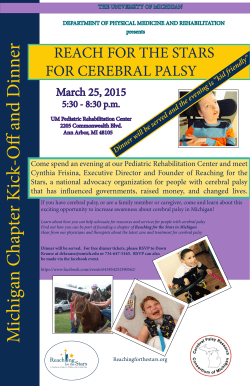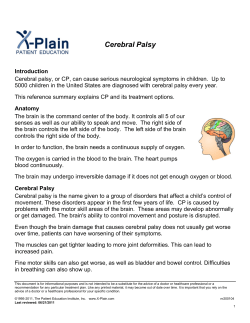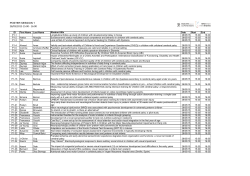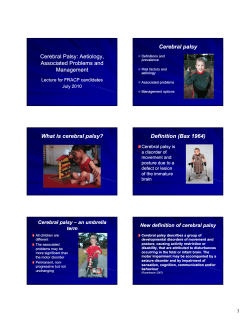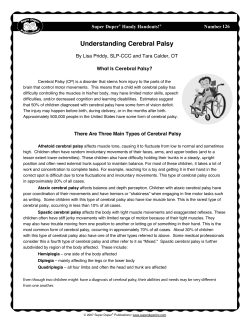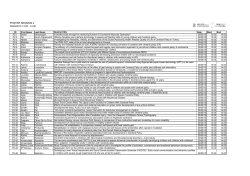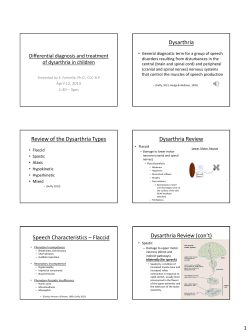
Hydranencephaly and Cerebral Palsy by Alicia Harper
Hydranencephaly and Cerebral Palsy by Alicia Harper Hydranencephaly and Cerebral Palsy One of the first bits of advice that I was given in the beginning of our journey, and one of the many that stayed in my mind for many months before I took heed to it, was that hydranencephaly would be easier to explain by just saying Cerebral Palsy (CP). I never researched how much truth was in this statement until the I tried for a year to explain what hydranencephaly was to questioning individuals who turned out to not seem to care as much as necessary for a full definition. I'd never actually known how broad of a condition CP was until researching and discovering what an umbrella of primary diagnoses this term actually blankets. It is a wee bit frustrating, that so many rare conditions such as hydranencephaly exist and are so easily classified into another group and forgotten about as an individual condition...maybe for hydran that will change one day! Cerebral Palsy is defined by the National Institute of Neurological Disorders and Stroke (NINDS) as: "...any one of a number of neurological disorders that appear in infancy or early childhood and permanently affect body movement and muscle coordination but don’t worsen over time. Even though cerebral palsy affects muscle movement, it isn’t caused by problems in the muscles or nerves. It is caused by abnormalities in parts of the brain that control muscle movements. The majority of children with cerebral palsy are born with it, although it may not be detected until months or years later. The early signs of cerebral palsy usually appear before a child reaches 3 years of age. The most common are a lack of muscle coordination when performing voluntary movements (ataxia); stiff or tight muscles and exaggerated reflexes (spasticity); walking with one foot or leg dragging; walking on the toes, a crouched gait, or a “scissored” gait; and muscle tone that is either too stiff or too floppy. A small number of children have cerebral palsy as the result of brain damage in the first few months or years of life, brain infections such as bacterial meningitis or viral encephalitis, or head injury from a motor vehicle accident, a fall, or child abuse." Since ultimately, a child with hydranencephaly has a traumatic brain injury (and many times has been shown to have had a stroke or other injury inutero)... I can definitely see how it would be easier to explain to curious onlookers. The main difference, and it's a big one, is that most children with "simple" CP do not necessarily suffer a terminal prognosis and many barely show lasting disabilities with early intervention and treatment. There are, however, MANY similarities. Spasticity is associated with many conditions to include CP, Hydran, Multiple Sclerosis (MS), spinal cord injuries, brain trauma or severe head injury, some metabolic diseases, and any other neuromuscular disorders. It is a condition affecting the central nervous system, in which certain muscles are continuously contracted causing stiffness/tightness and making it very difficult to move or speak, and sometimes even breath. There are varying degrees of spasticity, some like Brayden just have mild muscle stiffness which may or may not grow in to a more severe case, but others suffer more severely with uncontrollable, and often painful muscle uncontrolled spasms. Although automatically associated with these many conditions, it can be detected with the existence of increased muscle tone (hypertonicity), many series' of quick muscle contractions (clonus), stiff hard to move joints, exaggerated reflexes, etc. Many of these symptoms can be treated with daily stretches and movement...but ultimately must be treated with medications, and in some instances even surgery. Ataxia, the lack of coordination of gross motor skills, is also shown to be found in both CP & Hydran, among other conditions...although there are 3 types of ataxia, I think the one most often found in children with hydranencephaly would be Cereballar Ataxia due to the smaller than normal, or even total non-existence of the cerebellum. This type is directly correlated to dysfunction of the cerebellum, with or without brain lesions, causing various dysfunction dependent upon which portion of the brain is affected. For example, in children who display balance and lack of control of eye movement are said to have vestibulo-cerebellar dysfunction. While those with a terrible gait have spino-cerebellar dysfunction, and those who are unable to control voluntary movements are given the diagnosis of cerebrocerebellar dysfunction... all appropriately named by the area of the brain affected, being displayed in the associated lack of muscle control. There are also, I have found, many types of CP...to which one hydran children are most similarly compared to would depend on the child. The types are classified as to what parts of the body are affected, and in what ways they are affected. Here are the basic forms of CP from one of my favorite websites, 4MyChild: Help and Hope for Life (http://www.cerebralpalsy.org): "Spastic Cerebral Palsy is the most common diagnosis. If your child’s CP is “spastic,” her muscles are rigid and jerky, and she has difficulty getting around. There are three types of spastic Cerebral Palsy: Spastic diplegia — Your child’s leg and hip muscles are tight, and his legs cross at the knees, making it difficult to walk. This kind of movement is frequently referred to as “scissoring.” Spastic hemiplegia — Only one side of your child’s body is stiff. Her arms or hands might be more affected than her legs. On the affected side, her arm and leg may not develop normally. She may also require leg braces. Spastic quadriplegia — The severest of the three, spastic quadriplegia means that your child is more likely to have mental retardation if diagnosed as quadriplegia. His legs, arms, and body are affected. It will be difficult for him to walk and talk, and he may also experience seizures. Athetoid Dyskinetic Cerebral Palsy is the second most frequently diagnosed type of Cerebral Palsy. Your child will have normal intelligence, but her body will be totally affected by muscle problems. Her muscle tone can be weak or tight, and she might have trouble walking, sitting, or speaking clearly. She may also have trouble controlling her facial muscles and therefore drool. Ataxic Cerebral Palsy is the least diagnosed type of Cerebral Palsy. Your child will have trouble tying his shoes, buttoning his shirt, cutting with scissors, and doing other tasks that require fine motor skills. He might walk with his feet farther apart than normal and have trouble with his balance and coordination. Your child may also suffer from “intention tremors,” a shaking that begins with a voluntary movement. For example, your child may reach for a toy, and then his hand and arm will start to shake. As he gets closer to the toy, the tremor worsens. Hypotonic Cerebral Palsy which, unlike with other types of CP, you will notice that your baby has muscle control problems early in life. Her head seems floppy, and she will not be able to control it when sitting up. Her motor skills will be developmentally delayed. It is suspected that this type of Cerebral Palsy is caused by brain damage or malformations that occur while a baby’s brain is still developing. Mixed Cerebral Palsy is diagnosed if your child does not “fit” into one of the above diagnoses, your doctor will consider him “mixed.” This is quite common. Congenital Cerebral Palsy is not a “type” of palsy, but rather it is a term meaning “birth defect.” In other words, your child’s doctor is saying that he developed Cerebral Palsy during development. It is not a condition that your child inherited from you or your husband or partner. And it is not caused by a medical error. After once again reading those definitions, I would venture to say that many hydran children have a mix of all the various types throughout their lifetimes. Brayden has shown signs of Ataxic, Hypotonic, Athetoid Dyskinetic and it is definitely congenital. Every child with hydranencephaly varies in the degree of symptoms they have, just as any typically developing child varies, and that can change from one day to the next as well!.
© Copyright 2025
